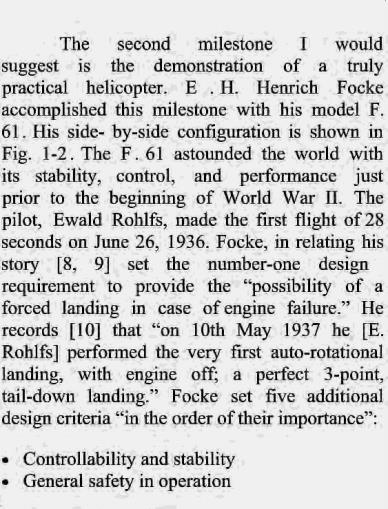
The second milestone I would suggest is the demonstration of a truly practical helicopter.E.H.Henrich Focke accomplished this milestone with his model F. 61.His side-by-side configuration is shown in Fig.1-2.The F.61 astounded the world with its stability,control,and performance just prior to the beginning of World War II.The pilot,Ewald Rohlfs,made the first flight of 28 seconds on June 26,1936.Focke,in relating his story [8,9]set the number-one design requirement to provide the "possibility of a forced landing in case of engine failure."He records [10]that "on 10th May 1937 he [E. Rohlfs]performed the very first auto-rotational landing,with engine off;a perfect 3-point, tail-down landing."Focke set five additional design criteria"in the order of their importance": Controllability and stability General safety in operation
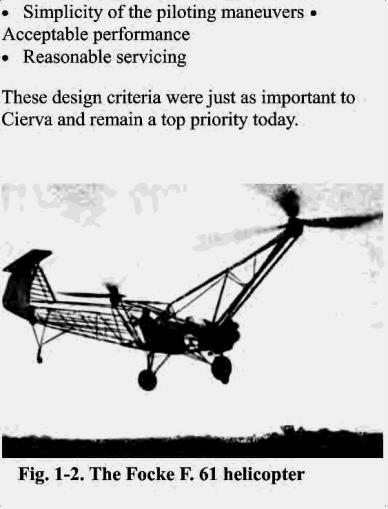
Simplicity of the piloting maneuvers. Acceptable performance Reasonable servicing These design criteria were just as important to Cierva and remain a top priority today. Fig.1-2.The Focke F.61 helicopter
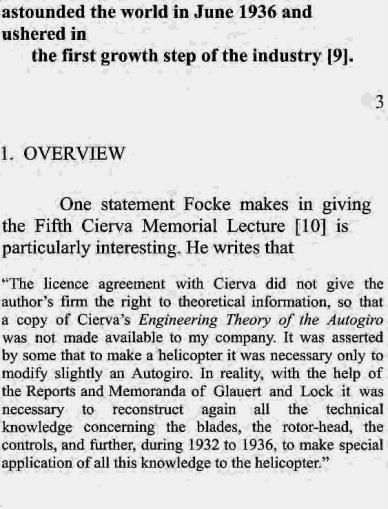
astounded the world in June 1936 and ushered in the first growth step of the industry [9]. 1.OVERVIEW One statement Focke makes in giving the Fifth Cierva Memorial Lecture [10]is particularly interesting.He writes that "The licence agreement with Cierva did not give the author's firm the right to theoretical information,so that a copy of Cierva's Engineering Theory of the Autogiro was not made available to my company.It was asserted by some that to make a helicopter it was necessary only to modify slightly an Autogiro.In reality,with the help of the Reports and Memoranda of Glauert and Lock it was necessary to reconstruct again all the technical knowledge concerning the blades,the rotor-head,the controls,and further,during 1932 to 1936,to make special application of all this knowledge to the helicopter
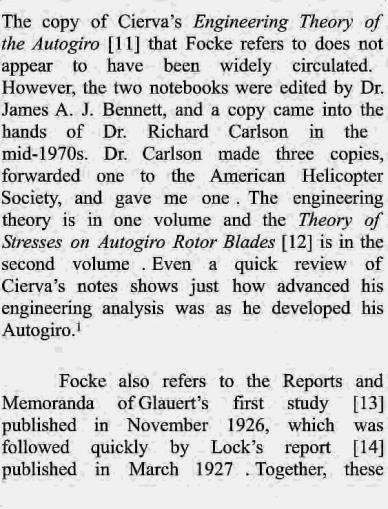
The copy of Cierva's Engineering Theory of the Autogiro [11]that Focke refers to does not appear to have been widely circulated. However,the two notebooks were edited by Dr. James A.J.Bennett,and a copy came into the hands of Dr.Richard Carlson in the mid-1970s.Dr.Carlson made three copies, forwarded one to the American Helicopter Society,and gave me one.The engineering theory is in one volume and the Theory of Stresses on Autogiro Rotor Blades [12]is in the second volume.Even a quick review of Cierva's notes shows just how advanced his engineering analysis was as he developed his Autogiro.1 Focke also refers to the Reports and Memoranda of Glauert's first study [13] published in November 1926, which was followed quickly by Lock's report [14] published in March 1927 .Together, these
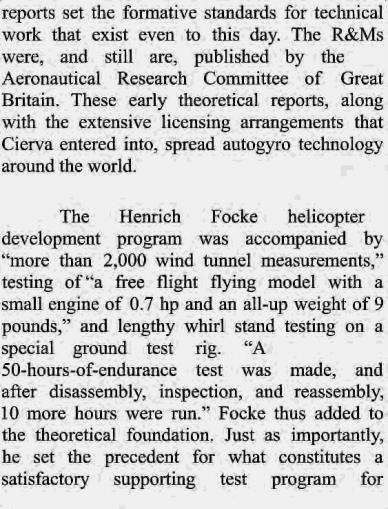
reports set the formative standards for technical work that exist even to this day.The R&Ms were,and still are,published by the Aeronautical Research Committee of Great Britain.These early theoretical reports,along with the extensive licensing arrangements Cierva entered into,spread autogyro technology around the world. The Henrich Focke helicopter development program was accompanied by more than 2,000 wind tunnel measurements," testing of"a free flight flying model with a small engine of 0.7 hp and an all-up weight of 9 pounds,"and lengthy whirl stand testing on a special ground test rig."A 50-hours-of-endurance test was made,and after disassembly,inspection,and reassembly, 10 more hours were run."Focke thus added to the theoretical foundation.Just as importantly, he set the precedent for what constitutes a satisfactory supporting test program for